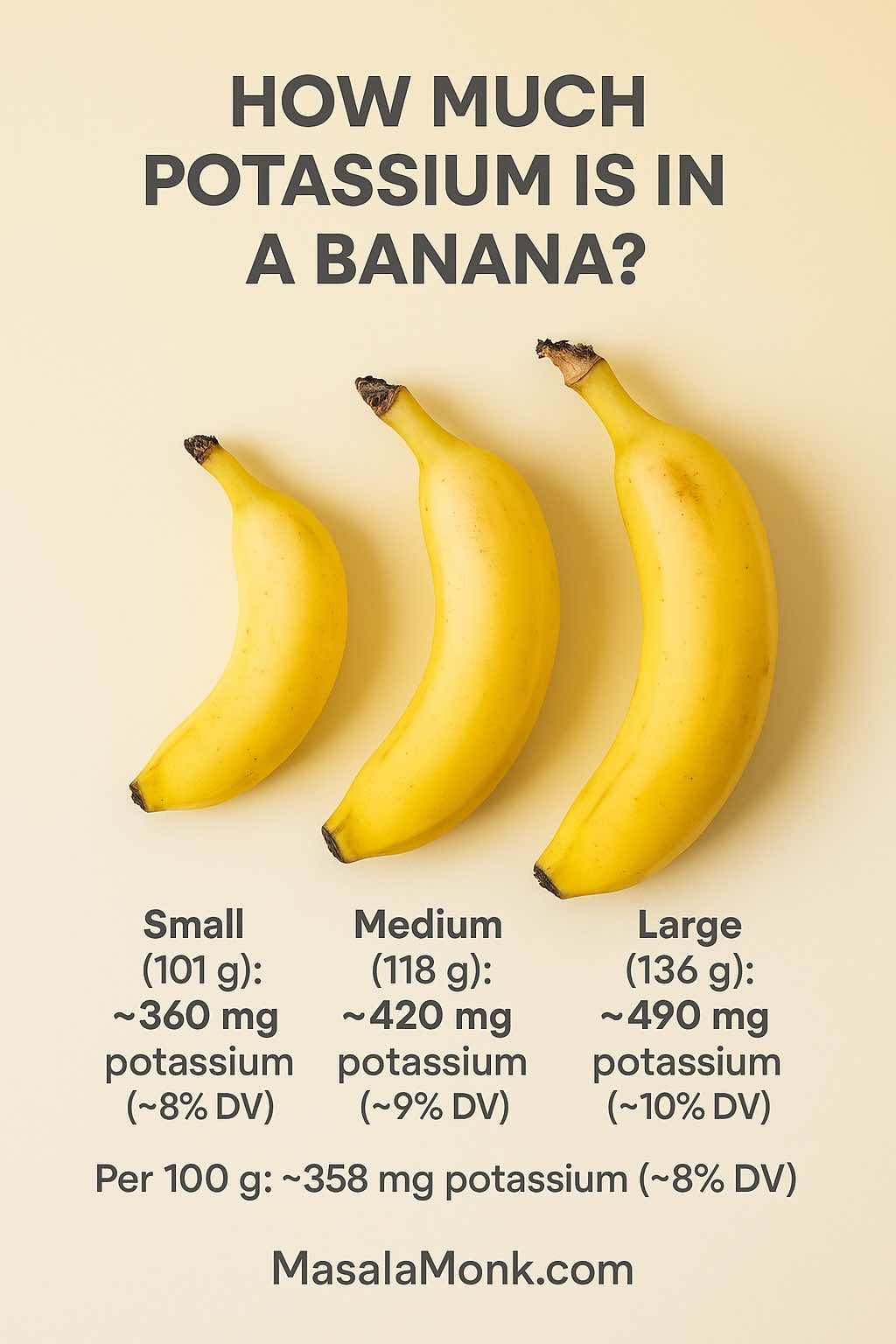
Introduction: Bananas and Potassium — The Famous Pair
When you hear the word potassium, chances are you picture a banana. For decades, bananas have carried the reputation of being the “potassium fruit.” They’re in school lunchboxes, marathon snack stations, and almost every nutrition conversation about electrolytes.
But here’s the real question: how much potassium is actually in a banana? And are bananas truly the best source, or do other foods like potatoes, avocados, or even lentils quietly outshine them?
In this guide, we’ll dig into the details. You’ll see the exact potassium content of bananas per size and per 100 grams, how bananas compare to other potassium-rich foods, and whether eating one (or two) a day is enough to make a difference. Along the way, we’ll also talk about why potassium matters so much for your health, and a few situations — like kidney disease — where bananas may not be the best option.
👉 Bananas are nutritious for most people, but if you’re managing blood sugar, read our guide on banana and diabetes to enjoy them safely.
Why Potassium Matters for Your Health
Potassium is one of those minerals you rarely think about — until you don’t have enough of it. When your intake falls short, you might notice cramps after a workout, a racing heartbeat, or just feeling worn down. Get the right amount, and potassium quietly supports nearly every system in your body.
Here’s what this mineral does for you:
- Keeps blood pressure in check — Potassium balances out sodium. If your diet is heavy on salt (think packaged snacks and fast food), potassium helps relax blood vessels and prevent your pressure from climbing too high (CDC).
- Supports muscles and nerves — Every heartbeat, every step, every reflex — they all rely on potassium’s role in electrical signaling (NIH ODS).
- Regulates fluids — Alongside sodium, potassium helps decide how much water stays inside your cells versus outside them.
- Protects bones and kidneys — A potassium-rich diet reduces calcium loss, supports bone strength, and lowers the risk of kidney stones.
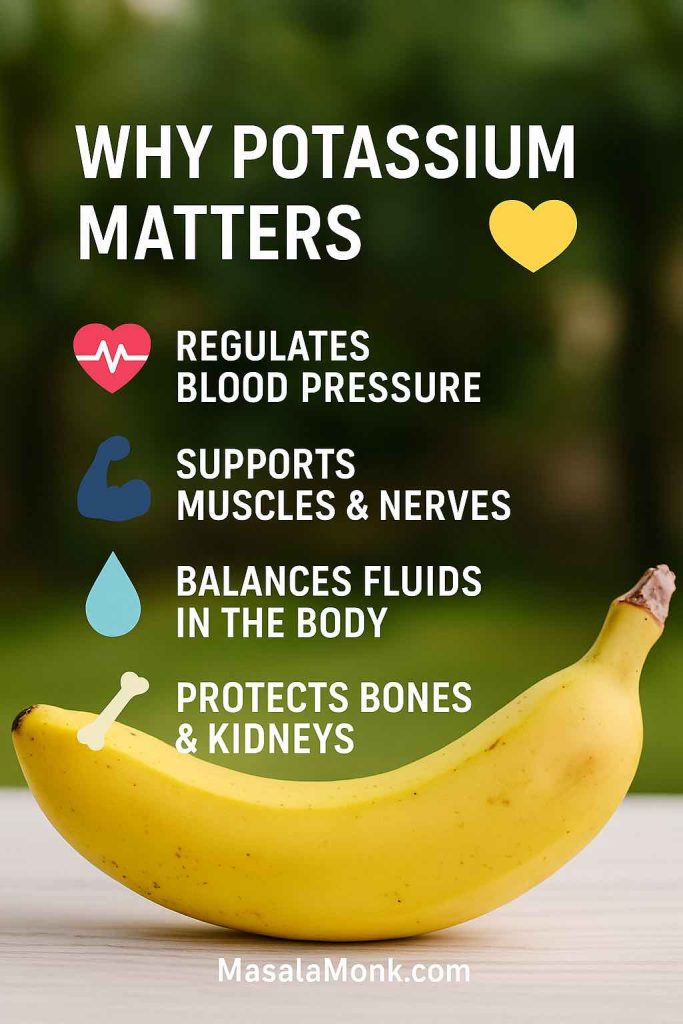
The recommended intake for adults is about 4,700 mg per day (Tufts Nutrition). The surprising truth? Fewer than 2% of Americans consistently get that much (Verywell Health). That’s where foods like bananas step in — they’re portable, affordable, and contribute a meaningful boost to your daily potassium.
👉 Low intake can cause fatigue, cramps, and more. See symptoms of low potassium in females to know when your body might be signaling a deficiency.
How Much Potassium Is in a Banana? (Per Size & Per 100 g)
Not all bananas are created equal. The potassium you get depends on size:
| Banana Size | Average Weight | Potassium (mg) | % Daily Value (DV) |
|---|---|---|---|
| Small (6 in) | ~101 g | ~360 mg | ~8% DV |
| Medium (7 in) | ~118 g | ~420 mg | ~9% DV |
| Large (8 in) | ~136 g | ~490 mg | ~10% DV |
👉 Per 100 grams of banana: about 358 mg of potassium (~8% DV) (WebMD)
In practical terms, eating a medium banana gives you nearly one-tenth of your daily potassium needs in a single snack (EatingWell). Add a second banana to your day, and you’ve covered almost 20%. That’s why bananas are seen as such an easy, everyday way to get this important nutrient.
Are Bananas Really High in Potassium?
Bananas have earned a reputation as the “potassium fruit,” but are they truly high in this mineral? The short answer is yes — bananas are a good source of potassium.

A medium banana offers about 420 mg of potassium, which qualifies as a good source since it’s well above the 200 mg cutoff nutrition experts use (NIH ODS). That makes bananas a reliable and consistent way to get potassium into your diet.
But here’s the longer answer: compared to other foods, bananas sit somewhere in the middle of the pack. They easily beat fruits like apples or oranges in potassium, but they can’t quite keep up with potatoes, beans, spinach, or avocados (Healthline).
So while bananas may not be the ultimate heavyweight, they still deserve their reputation. They’re quick, convenient, and predictable — you know exactly what you’re getting when you peel one.
Banana Potassium Level Compared to Daily Value
Here’s where perspective matters. Adults should aim for about 4,700 mg of potassium per day.
Now let’s put bananas into that context:
- 1 medium banana: ~420 mg → ~9% of daily value
- 2 bananas: ~840 mg → ~18%
- 3 bananas: ~1,260 mg → ~27%
On their own, bananas won’t meet your daily potassium needs — you’d have to eat 11 or more to get close (Tufts Nutrition). That’s not practical (or recommended).
Instead, think of bananas as a building block. Eating one or two daily is a great start, but you’ll want to fill the rest of your potassium needs with other foods like potatoes, beans, greens, and dairy.
👉 In other words: bananas aren’t the whole story, but they’re an easy and tasty way to move in the right direction.
Banana Potassium Compared to Other Foods
Let’s put bananas into context. Here’s how they stack up against common potassium foods:
| Food | Serving Size | Potassium (mg) | % DV |
|---|---|---|---|
| Banana (medium) | 118 g | 420 mg | 9% |
| Potato, baked with skin | 173 g | 900 mg | 19% |
| Sweet potato, baked | 130 g | 540 mg | 12% |
| Avocado (half) | 100 g | 700 mg | 15% |
| Kiwi (1 medium) | 76 g | 215 mg | 5% |
| Orange (1 medium) | 131 g | 240 mg | 5% |
| Spinach (cooked, 1 cup) | 180 g | 840 mg | 18% |
| Lentils (cooked, 1 cup) | 200 g | 730 mg | 16% |
👉 Bananas rank well, but potatoes, spinach, beans, and avocados can deliver nearly twice as much potassium per serving.
You can even blend potassium-rich foods like bananas and spinach into hydration boosters — try our DIY electrolyte drinks.
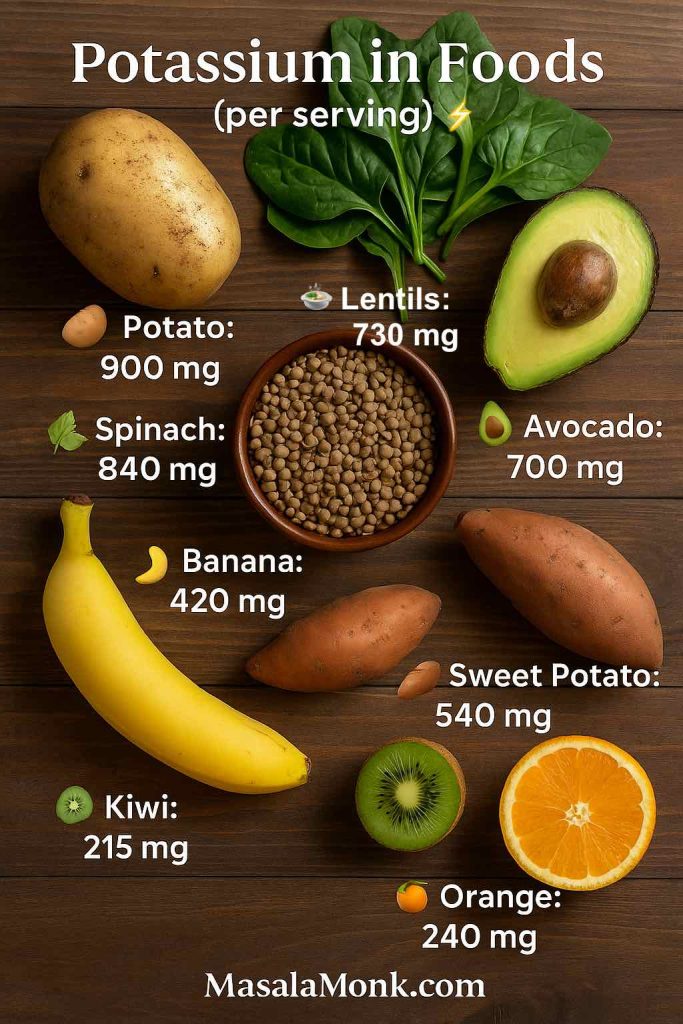
Banana vs Potato Potassium — Which Has More?
This one surprises a lot of people. A baked potato with skin can deliver nearly 900 mg of potassium — more than double what a medium banana provides. Even sweet potatoes are impressive, offering around 540 mg per cup when baked.
- Medium banana: ~420 mg potassium
- Baked potato (with skin, 173 g): ~900 mg potassium
Potatoes nearly double the potassium of a banana. Sweet potatoes also outperform bananas, with ~540 mg per medium baked serving.
👉 If your goal is maximum potassium per bite, potatoes win. But bananas win on portability and convenience.
So yes, potatoes beat bananas in this competition. But bananas still hold their own as a quick grab-and-go option without the need for cooking.
Avocado vs Banana Potassium Content
Half an avocado gives you about 700 mg of potassium. That means even a modest serving edges out a banana. Avocados also bring healthy fats and fiber to the table, making them a nutritional powerhouse. Of course, they’re not quite as convenient as tossing a banana in your bag.
- Half an avocado (~100 g): ~700 mg potassium
- Medium banana (~118 g): ~420 mg potassium
Avocados easily beat bananas here. They also provide so many other nutrients and a creamy texture that makes them great in meals. But bananas remain the easier snack-on-the-go choice.
Kiwi vs Banana Potassium Comparison
One kiwi provides about 215 mg of potassium — about half of what’s in a medium banana. But here’s the twist: kiwis have fewer calories, so if you compare potassium per calorie, kiwis look very impressive. They’re also rich in vitamin C and antioxidants, so pairing them with bananas makes for a nutrient-packed snack.
- One kiwi (76 g): ~215 mg potassium
- Medium banana (118 g): ~420 mg potassium
On a per-fruit basis, bananas double kiwis. But per calorie, kiwis are competitive since they’re lighter and nutrient-dense.
Oranges vs Bananas for Potassium
A medium orange has around 240 mg of potassium. That’s less than a banana, but still meaningful. Orange juice, especially fresh-squeezed, can bump the number up quickly, although it comes with more sugar than a whole fruit.
- Medium orange (131 g): ~240 mg potassium
- Medium banana (118 g): ~420 mg potassium
Bananas beat oranges here. But oranges bring vitamin C and hydration, so they complement each other well.
Bananas vs Beans and Leafy Greens
If we widen the lens beyond fruit, bananas fall further down the ranking. A cup of lentils has ~730 mg of potassium, spinach has ~840 mg, and beans are in the 600+ mg range.
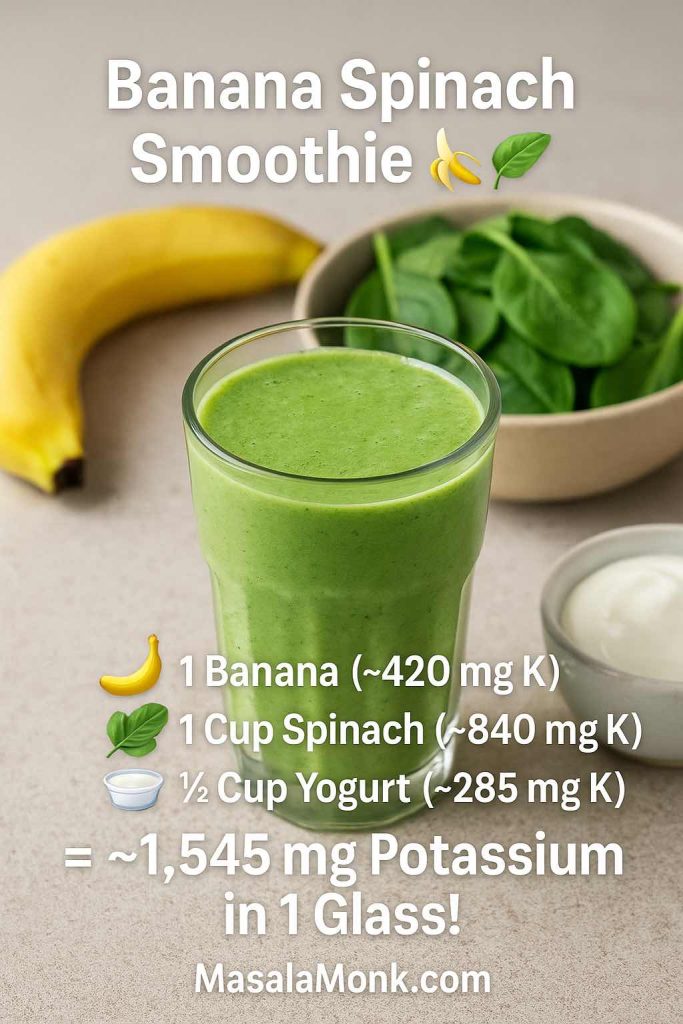
👉 These foods aren’t as “grab-and-go” as bananas, but they’re the real potassium champions — especially when you’re aiming to hit that 4,700 mg target.
Foods With More Potassium Than Bananas
Here are some heavy hitters:
- Spinach (1 cup cooked): ~840 mg potassium
- Lentils (1 cup cooked): ~730 mg potassium
- Beans (1 cup black beans, cooked): ~610 mg potassium
- Yogurt (1 cup plain): ~570 mg potassium
- Salmon (6 oz): ~534 mg potassium
👉 Clearly, bananas are helpful — but they’re not the “king” of potassium (Cleveland Clinic, Medical News Today, Real Simple).
Banana Potassium Levels and Ripeness
One common question is whether the potassium level of a banana changes as it ripens. The short answer? Not by much.
- Green bananas: Higher in resistant starch, lower in sugar. Potassium is about the same (~358 mg per 100 g).
- Yellow bananas: The classic ripe stage. Starch converts into sugar, but potassium stays steady.
- Brown or overripe bananas: Softer, sweeter, great for baking — and yes, the potassium content is still intact.
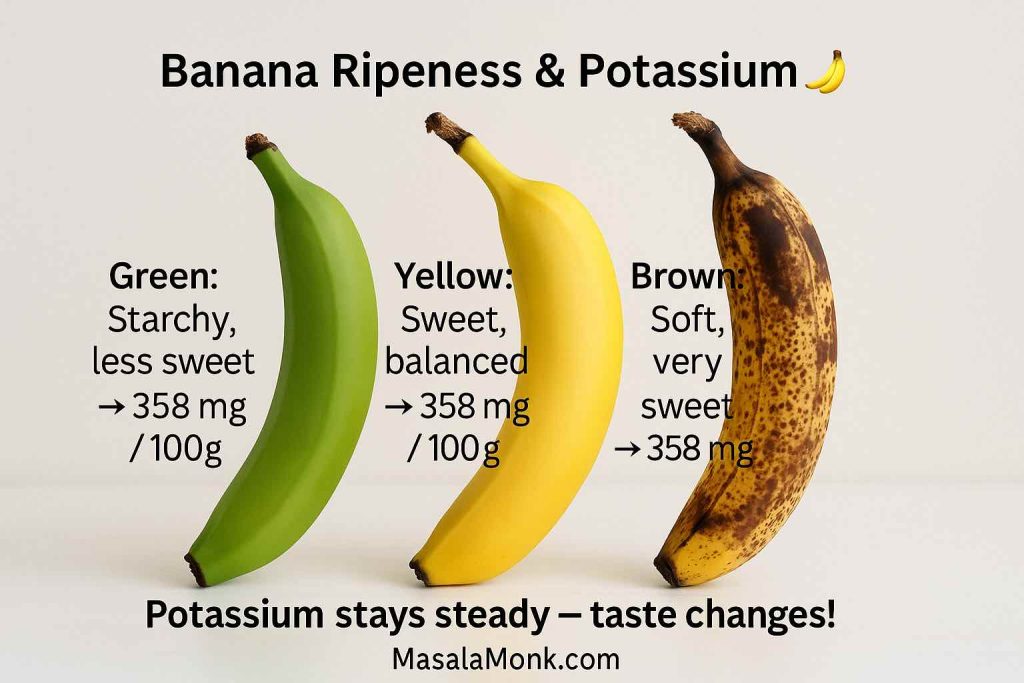
👉 In other words, whether your banana is green, bright yellow, or spotty brown, the potassium level doesn’t really change. What shifts is the texture and taste. Btw – Overripe bananas aren’t just good for bread — they also have benefits for skin care. Discover banana’s sweet skin benefits.
Do Bananas Keep Potassium in Different Forms?
Not all bananas come fresh from the peel. Let’s look at how potassium holds up in other banana-based foods:
- Banana chips (fried or dried): The potassium is still there, but you eat less by weight and often get extra oil, sugar, and calories.
- Banana bread: A slice contains some potassium, but much less than the whole fruit — usually ~70–100 mg, since it’s diluted with flour and sugar.
- Plantains: These starchy cousins of bananas are potassium heavyweights. A cup of cooked plantains can deliver nearly 900 mg, rivaling potatoes.
👉 Bottom line: bananas in all forms contribute potassium, but nothing beats the simple, fresh fruit for nutrient density.
Why Did Bananas Become the Potassium Icon?
If potatoes, spinach, and beans have more potassium, why do bananas get all the credit? A few reasons explain it:
- They’re incredibly convenient. Bananas come in their own wrapper. No washing, no peeling tools, no cooking. Just grab, peel, and eat.
- They taste good. Naturally sweet, soft, and kid-friendly, bananas appeal to almost everyone.
- They had a PR boost. In the mid-20th century, nutrition campaigns often highlighted bananas as the potassium food. That image stuck, and decades later, it’s still the fruit most of us associate with potassium.
👉 In short, bananas aren’t the richest source of potassium, but they became the icon because they’re easy, tasty, and memorable.
Bananas and Kidney Health: A Special Consideration
For most people, bananas are a safe, beneficial way to get more potassium. But if you have chronic kidney disease (CKD), the story changes.
Your kidneys act like filters, removing extra potassium from the blood. When they’re not working properly, potassium can build up — a condition called hyperkalemia. Too much potassium in the bloodstream may cause muscle weakness, irregular heartbeats, or even more serious complications (WebMD).
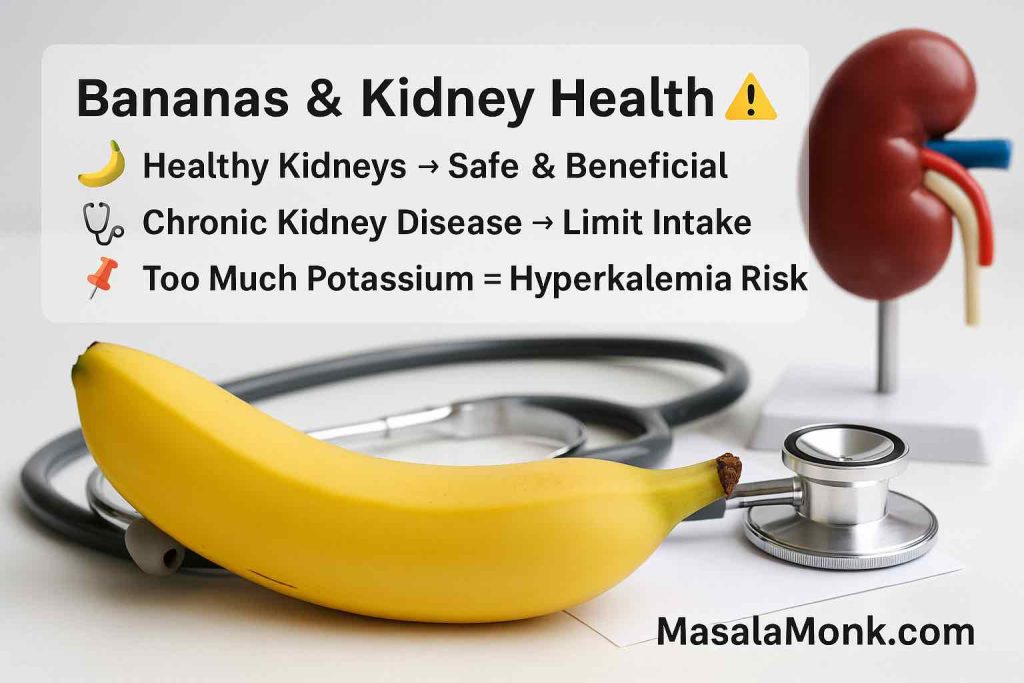
That’s why people with CKD are often told to limit or avoid high-potassium foods like bananas, potatoes, or beans. How much you can safely eat depends on your stage of kidney disease and your doctor’s guidance.
👉 If your kidneys are healthy, bananas are a smart addition to your diet. But if you’ve been diagnosed with kidney disease, check with your healthcare provider before making bananas a daily habit.
For healthy kidneys, focus on variety and balance — here’s how to increase electrolytes naturally at home.
How Many Bananas Should You Eat a Day for Potassium?
A medium banana gives you about 420 mg of potassium, or roughly 9% of what you need in a day. That’s a meaningful contribution, but bananas alone won’t get you to the full 4,700 mg daily goal.
So how many bananas make sense?
- 1–2 bananas a day → A sweet spot for most people. Enough to give your potassium a boost without overdoing it.
- 3–4 bananas a day → Still fine if you love them, but not necessary if you’re eating other potassium-rich foods.
- 10+ bananas a day → Not realistic, and not wise. Eating that many could push potassium to unsafe levels, especially if you have kidney issues.
👉 Think of bananas as part of a team. They’re a great contribution, but the best potassium strategy is variety: mix in potatoes, beans, greens, and yogurt to cover your bases.
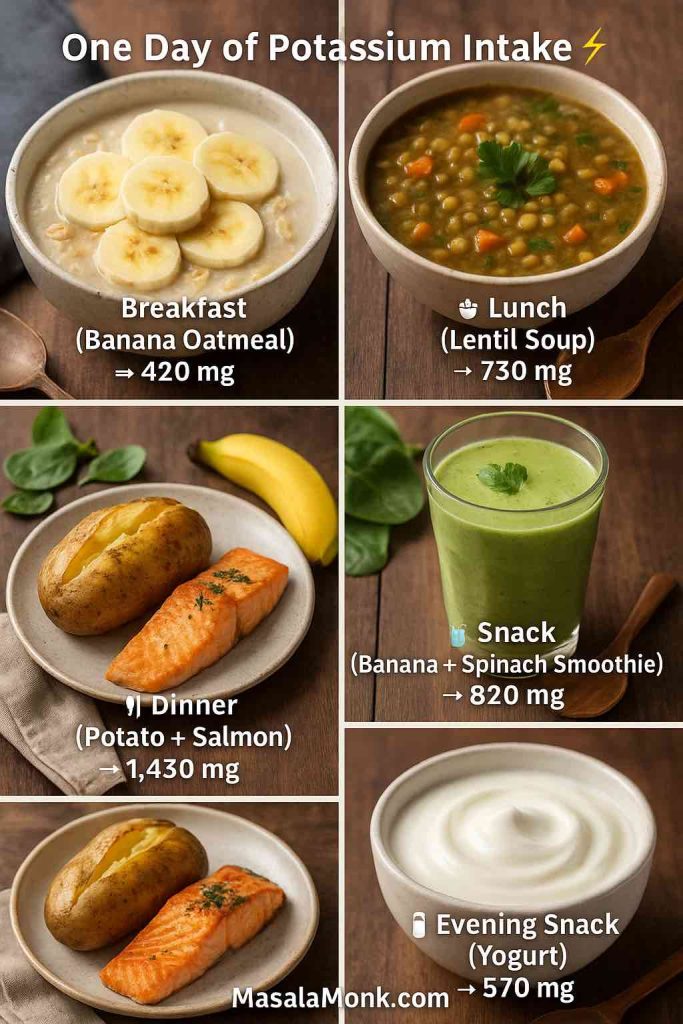
Example Day of Potassium Intake (With Bananas Included)
Here’s what a normal day might look like if you want to hit your potassium goals without obsessing over numbers:
- Breakfast: Oatmeal topped with banana slices (~420 mg)
- Lunch: Lentil soup (~730 mg)
- Snack: Smoothie with spinach + banana (~400 mg + 420 mg)
- Dinner: Baked potato (~900 mg) + salmon (~530 mg)
- Evening snack: Yogurt (~570 mg)
That’s nearly 4,000 mg of potassium, and you only ate two bananas. Add a few beans, another fruit, or a second serving of greens and you’re right at the daily target — without ever feeling like you were trying too hard.
Bananas for Athletes: Potassium and Muscle Cramps
If you’ve ever watched a marathon or tennis match, you’ve probably seen athletes munching on bananas mid-event. There’s a reason for that.
- Quick energy: The natural sugars in bananas provide fast fuel.
- Electrolyte balance: Potassium helps keep muscles contracting properly, reducing the chance of cramps.
- Portability: You can’t exactly carry a bowl of lentils onto a tennis court, but you can stick a banana in your bag.
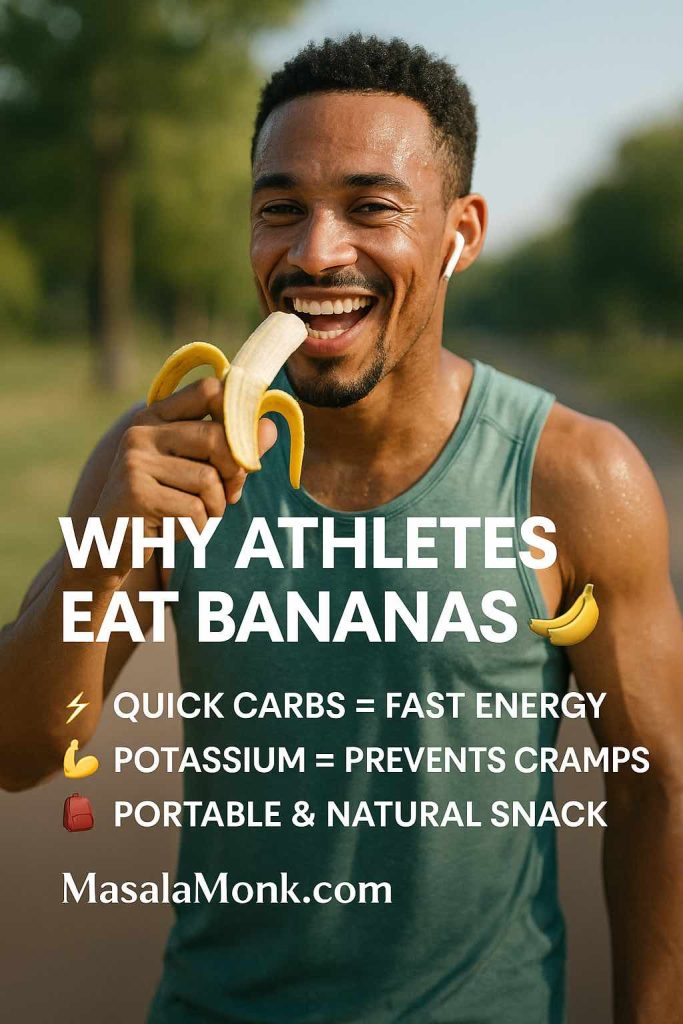
👉 For athletes, bananas strike a perfect balance: part snack, part electrolyte support, part energy boost — without the artificial additives you’d find in many sports drinks. For recovery ideas, try our post-workout electrolyte drink recipes.
Bananas, Magnesium, and Electrolyte Balance
While potassium usually steals the spotlight, bananas also provide another key mineral: magnesium. A medium banana contains about 32 mg of magnesium, which may not sound like much, but it works hand in hand with potassium.
Together, potassium and magnesium act like teammates:
- Potassium helps keep muscles contracting properly.
- Magnesium helps them relax afterwards.
That’s why both matter for preventing cramps, steadying your heartbeat, and keeping your energy levels balanced.
👉 When you eat a banana, you’re not just getting potassium — you’re also supporting your body’s broader electrolyte network. If you’re expecting, you can also enjoy potassium and magnesium through refreshing electrolyte-rich mocktails
Key Takeaways: Banana Potassium Content
- Per 100 g banana: ~358 mg potassium (~8% DV).
- Medium banana: ~420 mg potassium (~9% DV).
- Bananas are a good source of potassium, but not the richest option.
- Potatoes, beans, avocados, lentils, and spinach often contain more.
- For most people, 1–2 bananas a day is a healthy way to boost potassium.
- People with chronic kidney disease may need to limit or avoid bananas.
- Bananas also bring magnesium, natural sugars, and convenience — making them a smart, everyday snack.
The Bottom Line: Are Bananas a Good Source of Potassium?
Yes — bananas deserve their place as one of the world’s favorite potassium foods. A medium banana gives you around 420 mg of potassium, making it a tasty and convenient way to cover nearly 10% of your daily needs.
But it’s also true that bananas aren’t the only game in town. Potatoes, beans, leafy greens, yogurt, salmon, and avocados can give you even more potassium per serving.
So here’s the big picture: bananas aren’t the king of potassium, but they are one of the easiest ways to get it. They’re portable, naturally sweet, and pair beautifully with other foods that round out your diet.
👉 Next time someone says “bananas are high in potassium,” you’ll know the full story — yes, they are, but sometimes the humble baked potato gets to wear the crown.
🍌 Frequently Asked Questions About Bananas and Potassium
1. How much potassium is in one banana?
A medium banana (about 118 g) contains around 420 mg of potassium (confirmed by EatingWell), which is close to 9% of the recommended daily intake for adults. Smaller bananas have about 360 mg, while larger ones can reach nearly 490 mg. Per 100 g, bananas provide about 358 mg of potassium.
2. Do bananas really have a lot of potassium?
Yes — bananas are a good source of potassium. While they aren’t the highest food source, they’re practical and easy to eat. For context, a banana’s ~420 mg of potassium is more than an orange (240 mg) or a kiwi (215 mg), but less than a baked potato (900 mg) or spinach (840 mg per cup) (Healthline).
3. Are bananas the best source of potassium?
Not exactly. Bananas are popular because they’re portable, sweet, and widely available. But foods like potatoes, beans, lentils, spinach, and avocados actually provide more potassium per serving. Think of bananas as one helpful piece of the potassium puzzle, not the whole picture. For ways to make up for the gap, see DIY electrolyte drinks for dehydration.
4. How many bananas should I eat a day for potassium?
For most healthy adults, 1–2 bananas per day is a great way to boost potassium intake. Even 3–4 can be fine, but it’s best to mix bananas with other potassium-rich foods. Eating 10+ bananas daily is not recommended — it’s unrealistic and could raise potassium too high if your kidneys can’t keep up.
If you’re diabetic, you may want to follow banana and diabetes tips to enjoy them safely.
5. How many milligrams of potassium are in a banana?
On average:
- Small banana (101 g): ~360 mg
- Medium banana (118 g): ~420 mg
- Large banana (136 g): ~490 mg
👉 That’s why you’ll often see “~420 mg potassium per banana” listed as the standard number.
6. Does ripeness affect banana potassium levels?
Not much. Whether your banana is green, yellow, or overripe, the potassium stays roughly the same (~358 mg per 100 g). What changes is the starch-to-sugar ratio — green bananas are starchier, while ripe ones are sweeter.
Overripe bananas? Perfect for baking or even skincare — see our banana skin care recipes.
7. Do potatoes have more potassium than bananas?
Yes. A baked potato with skin contains about 900 mg of potassium, more than double a banana (Cleveland Clinic). Sweet potatoes also edge bananas with around 540 mg per serving. Bananas are still convenient, but potatoes are true potassium heavyweights.
And if you want to hydrate smarter, try pairing potatoes with homemade electrolyte drink recipes that may also use bananas.
8. Do sweet potatoes have potassium too?
Absolutely. A medium baked sweet potato has around 540 mg of potassium (~12% DV). That’s more than a banana and comes with extra fiber and vitamin A.
9. What foods have potassium besides bananas?
Plenty! Some excellent potassium-rich foods other than bananas include:
- Potatoes and sweet potatoes
- Avocados
- Lentils and beans
- Spinach and other leafy greens
- Yogurt
- Salmon
👉 Combining these with bananas is the best way to reach your daily potassium needs. Besides, you can combine them into nutritious nut-infused smoothies for a potassium + protein boost.
10. Which fruits have more potassium than bananas?
Some fruits can outshine bananas in potassium:
- Avocado (½ fruit): ~700 mg
- Dried apricots (½ cup): ~750 mg
- Pomegranate (1 fruit): ~666 mg
Bananas still rank well, but avocados in particular are much higher per serving (Verywell Health).
11. Do avocados have more potassium than bananas?
Yes. A half avocado has about 700 mg of potassium, compared to ~420 mg in a banana. That’s one reason avocados are considered nutritional powerhouses.
12. Do kiwis have more potassium than bananas?
Not quite. One kiwi has around 215 mg of potassium, which is about half a banana. However, kiwis are very nutrient-dense for their size and calories, so they’re still a great choice.
13. Do oranges have more potassium than bananas?
No. A medium orange has about 240 mg, while a banana has ~420 mg. Still, oranges provide vitamin C and hydration, so they’re a great complement to bananas.
14. Do plantains have potassium?
Yes — and lots of it. A cup of cooked plantains delivers nearly 900 mg of potassium, rivaling a baked potato.
15. Do banana chips or banana bread still have potassium?
- Banana chips: Yes, but portion sizes are smaller and often fried with added sugar or oil.
- Banana bread: Still has potassium, but much less per slice (~70–100 mg) compared to a whole banana.
Fresh bananas are the most nutrient-dense option.
16. When do bananas have the most potassium?
Potassium levels stay fairly consistent regardless of ripeness. What changes is texture and taste: green bananas are starchier, yellow ones sweeter, and brown ones best for baking.
17. Are bananas safe for people with kidney disease?
If you have healthy kidneys, bananas are safe and beneficial. But if you have chronic kidney disease (CKD), you may need to limit or avoid bananas. That’s because weak kidneys can’t filter potassium properly, leading to hyperkalemia (too much potassium in the blood). Always check with your doctor if you’re on a low-potassium diet.
For healthy individuals, bananas are fine — but also learn how to balance electrolytes naturally to keep your diet varied.
18. Can eating too many bananas cause too much potassium?
For most healthy people, it’s very hard to overdo potassium with food alone. However, eating very large amounts (10+ bananas daily) could raise potassium too high, especially if you have kidney problems. Balance is key.
19. Do bananas have magnesium as well as potassium?
Yes! A medium banana has about 32 mg of magnesium, in addition to ~420 mg potassium. Both work together to support muscle and nerve function.
20. Why are bananas always linked with potassium?
Bananas became the “potassium fruit” for three reasons:
- They’re portable and easy to eat anywhere.
- They taste good to almost everyone.
- They were heavily promoted in nutrition campaigns decades ago.
👉 While they aren’t the richest source, bananas remain the most recognizable and accessible source of potassium worldwide.
📚 Sources
- National Institutes of Health (NIH): Potassium — Consumer Fact Sheet
- Centers for Disease Control and Prevention (CDC): Sodium and Potassium
- Tufts Nutrition Letter: Potassium Power
- Healthline: 15 Foods That Pack More Potassium Than a Banana
- Cleveland Clinic: Potassium-Rich Foods
- WebMD: Foods Rich in Potassium
- Verywell Health: Foods High in Potassium
- Medical News Today: Foods High in Potassium
- Real Simple: Foods With More Potassium Than Bananas
- EatingWell: The Best Time to Eat Bananas for Potassium









